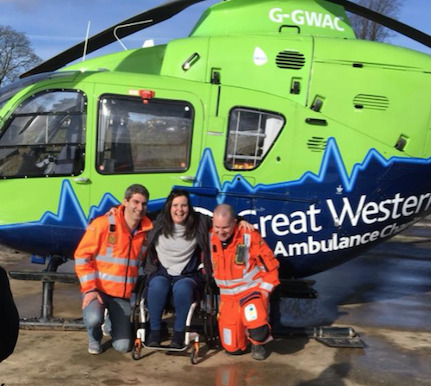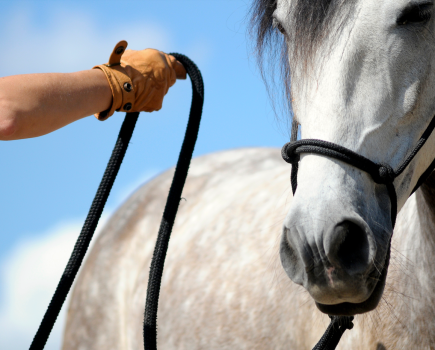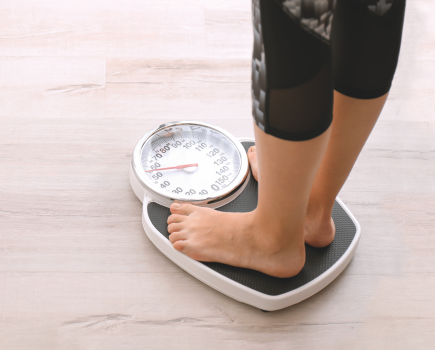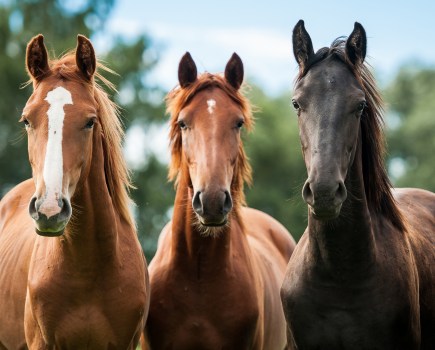It’s been well over two years since Sallyanne had her life-changing accident. Here she explains what happened when she recently visited the team that helped her on that fateful day.
Last month, I arranged a visit with the Great Western Air Ambulance charity (GWAA) to visit their air base at Filton, Gloucestershire to meet the crew who attended my accident a couple of years ago.
This has taken a little while to arrange as they had to go back over their records to find out who was working that day.
As it was the school holidays, my daughter Stella came with me, along with my dad, sister and niece.
Both my dad and my sister were with me in the field following my accident and they really wanted to meet the team who helped me on that day.
Arriving at Filton

We pulled up at Filton and were met by Becky Garland, the GWAA charity PR coordinator. She explained what the visit would entail and showed us into the air craft hanger.
She said that two out of the three team members were here and looking forward to meeting me. It was at this point that I got a bit emotional. I had a horrible lump in my throat and tears started welling up in my eyes.
I realised I hadn’t thought much about the accident before now and, as a result, had put it all behind me.
When we walked through the door into the control hub, any feelings of anxiety vanished. We were met by the most amazing team of heroes you could ever imagine.
We were introduced to critical care doctor, Dr Ed Valentine, and critical care doctor, Dr Greg Cranston, both of whom were in attendance at my accident.
We also met critical care paramedics, Matt and Dee.
We all chatted a lot about the day and what happened. Dr Greg explained that he held my hand and positioned himself in my line of vision all the time, giving me reassurance.
It was this act of kindness that I’ll always remember. When I think back to that eventful day, I only remember being in extreme pain and having someone close to me, reassuring me all the time.
I now know that this was Dr Greg – I was so frightened and he’d made me feel safe.
One to remember
Dr Ed and Dr Greg said that they’d attended more than 400 call-outs since my accident, but they remembered things about that particular day because I was fully conscious throughout.
Normally a lot of patients they see are unconscious or need to be ventilated.
They laughed and remembered me telling them how much morphine I’d been given when they were talking among themselves. They remember me saying “I’ve had 15mg!”.
Both Greg and Ed are consultants in emergency medicine full time at the Royal Gwent hospital in Wales and work for GWAA charity on top of their normal hours. These guys are absolute heroes!
The team really welcomed me and my family and we chatted over coffee. They showed us the map and area they cover and described what happens when a call comes in, plus how they decide if they need a helicopter.
Keeping the helicopters running
 It costs the GWAA charity £2000 just to start the engines of their helicopters and £3,000,000 per year to keep flying.
It costs the GWAA charity £2000 just to start the engines of their helicopters and £3,000,000 per year to keep flying.
Some support does come from the NHS in the form of all disposables carried on board and for the treatment of patients.
The charity funds the lease of the helicopter as this is a more economical way of keeping a fully working helicopter, rather than owning it.
The charity has two permanent employed pilots and always requires a fully-qualified paramedic to act as navigator when they get a call out.
They work from 7am until 1am (they don’t fly at night) and also operate emergency critical care vehicles from this base.
After finding my place of injury on the map, Stella and I worked out that it’d take five minutes to get to me over in Chipping Sodbury.
It takes the team just three minutes from receiving the call until the helicopter leaves the ground.
All in all, it took about eight minutes from receiving the call to actually finding me and landing in the field on the day of my accident.
Having a tour
 Dr Greg took us outside to see the helicopter – this has been updated since my accident but it was still really interesting to see it and all its kit.
Dr Greg took us outside to see the helicopter – this has been updated since my accident but it was still really interesting to see it and all its kit.
It was a lot smaller than I imagined – goodness knows how the team manage to fit inside!
We spent ages looking around the helicopter and Stella and my niece, Jasmine, got to sit inside.
It doesn’t seem possible to fit someone on a stretcher, all the equipment plus three doctors and the pilot inside.
We all had such an amazing morning and have come away feeling inspired to fundraise for this amazing charity.
I did suggest a parachute jump (there weren’t many takers!), but in the end we’ve decided we want to organise a spring ball in 2019.
Until next time,
Sallyanne









